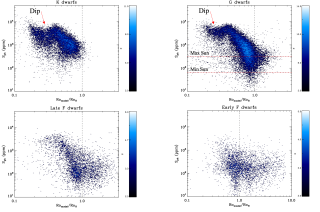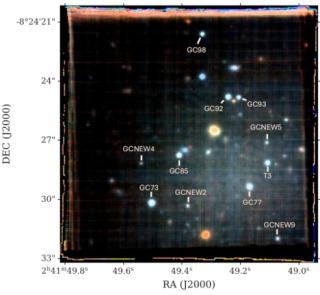Utilizando modelos semiempíricos de los espectros de fotoabsorción de varios fullerenos individuales (C_80, C_240, C_320 y C_540) predecimos transiciones en la región de la banda difusa más intensa del medio interestelar a 4430 A que podrían explicar su origen, hasta ahora desconocido. Estos modelos también presentan una alta densidad de transiciones en el ultravioleta que reproducen el denominado "bump" a 2175 A en la curva de extinción del medio interestelar (Iglesias-Groth 2004). Parece que los fullerenos podrían ser responsables de dos de los mayores rasgos de la absorción interestelar. Haciendo uso de las secciones eficaces teóricas y de los datos empíricos estimamos que la abundancia de fullerenos es de 0.05 moléculas por millón de átomos de hidrógeno en regiones del medio interestelar con índice de exceso de color E(B-V)~ 1.0.
Advertised on
It may interest you
-
 It’s been decades since the need to study other stars to understand the past, present and future of the Sun was realized. One important aspect that has been investigated is the magnetic activity of stars for which we cannot fully grasp the mechanisms involved. Indeed, the origin of stellar magnetic cycles or the dependence of the magnetic activity on the stellar properties are not completely understood. This knowledge improves not only our understanding of the physics involved in stellar evolution but also affects the study of the Sun to better predict high-energy events and the betterAdvertised on
It’s been decades since the need to study other stars to understand the past, present and future of the Sun was realized. One important aspect that has been investigated is the magnetic activity of stars for which we cannot fully grasp the mechanisms involved. Indeed, the origin of stellar magnetic cycles or the dependence of the magnetic activity on the stellar properties are not completely understood. This knowledge improves not only our understanding of the physics involved in stellar evolution but also affects the study of the Sun to better predict high-energy events and the betterAdvertised on -
 O ne of the key challenges in astronomy is to measure accurate distances to celestial objects. Knowing distances is crucial since it allows us to measure physical properties such as size, mass and luminosity. Since we can’t go out and use a tape-measure, a range of different approaches have been developed. Many of these approaches rely on using “standard candles”. Standard candles are objects (for example stars or supernovae) for which we know their intrinsic ”true” brightness. Once we know this, then their observed brightness compared to their intrinsic brightness gives us a distance to theAdvertised on
O ne of the key challenges in astronomy is to measure accurate distances to celestial objects. Knowing distances is crucial since it allows us to measure physical properties such as size, mass and luminosity. Since we can’t go out and use a tape-measure, a range of different approaches have been developed. Many of these approaches rely on using “standard candles”. Standard candles are objects (for example stars or supernovae) for which we know their intrinsic ”true” brightness. Once we know this, then their observed brightness compared to their intrinsic brightness gives us a distance to theAdvertised on -
 The Near-Infrared Spectrometer and Photometer (NISP) on board the Euclid space mission has obtained near-infrared (NIR) spectra of millions of objects, including hundreds of ultracool dwarfs (UCDs). Euclid observations retrieve images and slitless spectra simultaneously. This observing mode marks a new era in the discovery of new objects, such as L- and T-type dwarfs, which can be found from direct identification through the H2O and CH4 absorption bands. NISP spectral resolution (R ∼ 450) is enough to classify the objects by the spectral type using known standard templates. Q1 provided moreAdvertised on
The Near-Infrared Spectrometer and Photometer (NISP) on board the Euclid space mission has obtained near-infrared (NIR) spectra of millions of objects, including hundreds of ultracool dwarfs (UCDs). Euclid observations retrieve images and slitless spectra simultaneously. This observing mode marks a new era in the discovery of new objects, such as L- and T-type dwarfs, which can be found from direct identification through the H2O and CH4 absorption bands. NISP spectral resolution (R ∼ 450) is enough to classify the objects by the spectral type using known standard templates. Q1 provided moreAdvertised on